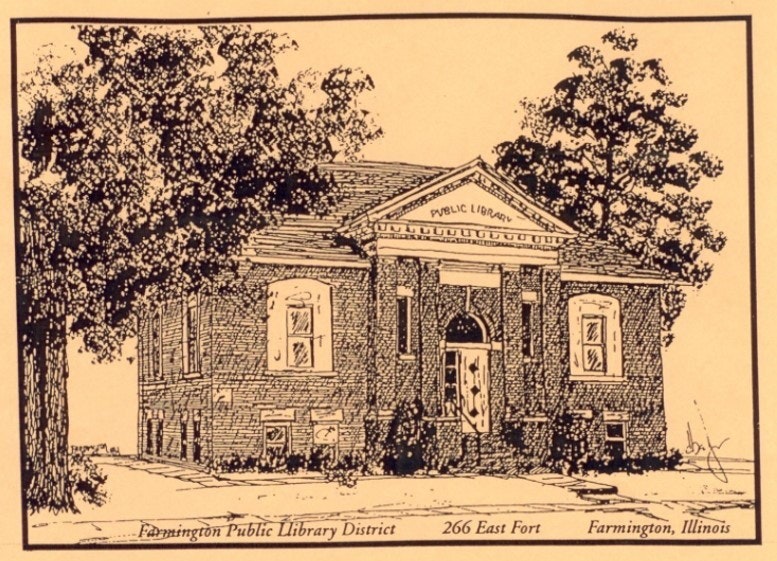History of the Farmington Area Public Library District

History of the Farmington Area Public Library District
By: Linda Schultz
The Farmington Public Library began 100 years ago. Still, the desire to have a library in Farmington goes back to the 1860s when dues and membership fees supported a circulating library. The circulating library did not last and over the next 30 years reading rooms would open for brief periods of time. In 1899 the Ministerial Association and the Ladies Library Association opened a reading room in the Reiplinger building on East Fort Street with donated books, magazines, and furnishings.
In April 1900 the citizens of Farmington voted to support a public library with a two-mill tax. Mayor Ambrose Dikeman and the city council appointed the first Library Board of Trustees composed of Rev. B.F. Eckley, Rev. E.A. Fredenhagen, Mrs. Emma Clark, Miss Bertha Lobaugh, L.J. Shuler, Charles M. Grey, H.F. Fahnestock, J.L. Dimmitt, and E.L. Cone. A year later after the tax money had been collected the library opened in Chapman School on April 4, 1901. Miss Bessie Clark, the librarian, had a collection of 119 books and some magazines. In April 1902 the library moved to an upstairs room in the City Building where it remained for the next five years. The collection had grown to 804 books.
The library board was interested in securing a permanent place for the library. In 1904 the board wrote Andrew Carnegie requesting a donation to build a library. Farmington did not meet the requirements. A year later Mrs. A.C. Steenburg, a Board member, learned that the requirements had been reduced to two. One, the city must provide a site for the library, and, two, it must support the library with an annual fund of 10% of the cost of the building. The cost of building a library was determined to be $5,600. The city council agreed to fund the library at $560 per year which was 10% of the cost of the building. Through public subscription the lot at 266 E. Fort St. was bought from J.S. McCoy for $550.
Paul O. Moratz from Bloomington was the architect chosen to build the library, and M. E. Sweeney of Galesburg was the contractor. Construction began on June 14, 1906, and was completed on January 11, 1907. Records indicate that bad weather and labor problems slowed down the construction, but on January 18, 1907, the Farmington Public Library opened with Miss Nellie McDonald as the librarian.
Throughout the past 100 years, many dedicated librarians have served the community. One of the most notable was Minta Schoonover who gave half a century of service. Hired in 1917 as Head Librarian, Miss Schoonover retired in 1967 at the age of 98. She was a conscientious librarian and a good steward of the collection.
The first catalogs of the library's collection were book catalogs containing all the author, title, and call number information of each book. Information taken from a 1915 Catalogue contained the following rules: the hours were Wednesdays and Saturdays from 2 to 8 p.m., borrowers had to be eleven years old and older to borrow books, only two library cards per household were allowed, only two books could be borrowed at a time, fines were 10 cents a week after the loan period of two weeks. In the 1930 Book of Rules, Regulation, and By-laws of the Free Public Library, Farmington still limited borrowers to 2 books, but the minimum age of cardholders dropped to ten years old. An interesting rule said, "Books in homes under quarantine for contagious diseases must be destroyed and the library reimbursed for their actual value." By 1970 the rules no longer limited the number of books borrowed, and the minimum age of cardholders dropped to six years of age. In 1970 the fines were the same as in 1915 (ten cents per week).
Milestones along the way:
- 1920s and 30s - Because of the Depression the city council wasn't always able to fund the library. Bake sales helped pay the bills. A bank holding the library's money closed in 1932 forcing the library to cancel a book order. The library continued to operate.
- 1960s- Many physical changes occurred during this decade: a new gas furnace was added and the wood floors were carpeted. In 1966 the library joined the Western Illinois Library System (WILS) and began a card catalog of the collection. In 1967 the library opened three days a week.
- 1970's- Physical changes: adding the parking lot, bulletin board, new clock, remodeling the windows, insulating the attic, new roof, and gutters. The nonresident fee was changed from one dollar to five dollars per year. By the end of the decade, the fee was changed to twenty dollars per year making it comparable to the taxes the residents paid to support the library.
- 1980s- New Equipment: added electric typewriter and photocopy machine with grant funds. The staff became involved in WILS and received advice on managing a library and applying for grants.
